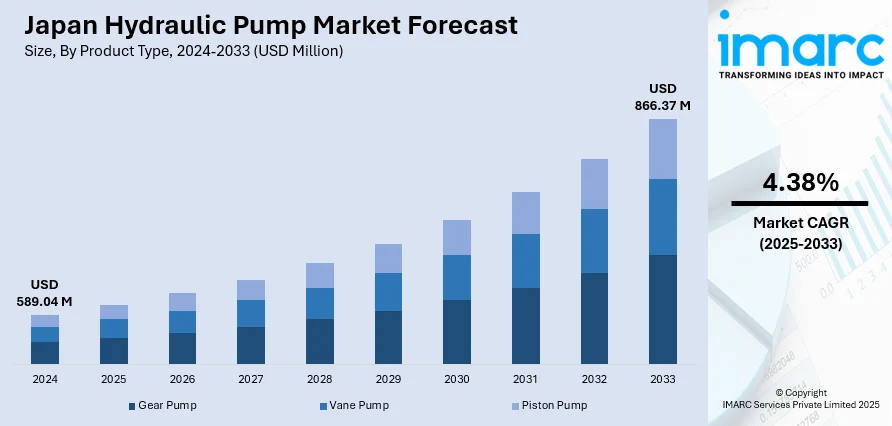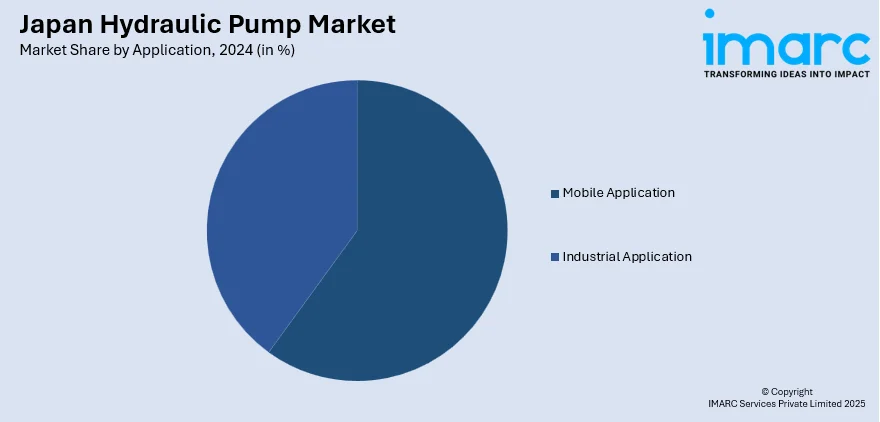
Japan Hydraulic Pump Market Size, Share, Trends and Forecast by Product Type, Pressure Range, Application, End User, and Region, 2025-2033
Japan Hydraulic Pump Market Overview:
The Japan hydraulic pump market size reached USD 589.04 Million in 2024. Looking forward, IMARC Group expects the market to reach USD 866.37 Million by 2033, exhibiting a growth rate (CAGR) of 4.38% during 2025-2033. The market is propelled by industrial automation, energy-efficient equipment demand, and increased interest in infrastructure development. Increased activity in construction, mining, and agriculture sectors further propels demand, leading to a consistent growth in the Japan hydraulic pump market share.
|
Report Attribute
|
Key Statistics
|
|---|---|
|
Base Year
|
2024
|
|
Forecast Years
|
2025-2033
|
|
Historical Years
|
2019-2024
|
| Market Size in 2024 | USD 589.04 Million |
| Market Forecast in 2033 | USD 866.37 Million |
| Market Growth Rate 2025-2033 | 4.38% |
Japan Hydraulic Pump Market Trends:
Technological Advancements in Hydraulic Pump Designs
Technological progress plays a major role in driving Japan's hydraulic pump market growth. Advanced material usage and stringent engineering allow for the production of high-performance pumps that are more durable, compact, and designed to handle higher pressure. This technological progress increases the overall efficiency and reliability of hydraulic systems used in industrial applications such as robotics, construction machinery, and aerospace. For example, in July 2024, Uber Technologies collaborated with Mitsubishi Electric and Cartken to introduce an online food delivery service in Tokyo through the use of autonomous robots incorporating hydraulic and pneumatic actuators. Hydraulic pumps, which are important for energizing actuators in robots, are particularly significant in systems that demand precise movement and force, connecting such a development to the hydraulic pump business. Furthermore, the integration of digital technologies, including IoT and smart sensors, is transforming hydraulic pump systems. These technologies allow for real-time monitoring and predictive maintenance, lowering downtime and enhancing system longevity. As a result, Japan hydraulic pump market growth continues to expand with these sophisticated and cutting-edge pump solutions.

Growth in Infrastructure and Construction Projects
Japan's infrastructure and construction boom continues to be a major driving factor behind the hydraulic pump market's growth. With more and more large-scale developments, construction development, transport infrastructure, and renewable energy projects being undertaken, the requirement for hydraulic pumps has grown significantly. Hydraulic systems are critical to the operation of heavy equipment employed in construction activities, e.g., excavators, bulldozers, and cranes. Moreover, the trend towards automation in construction and mining industry further creates the demand for high-performance hydraulic pumps. The efforts of the Japanese government to help finance infrastructure growth, together with investments from the private sector, guarantee a consistent demand for durable and effective hydraulic pumps. For instance, in October 2024, LBX Company LLC, a subsidiary of Sumito Construction Machinery with manufacturing operations in Chiba, Japan, introduced the Link-Belt 370 X4S hydraulic excavator. This new model incorporates advanced features such as dynamic stability assist, digital level, depth and height alarms, and a payload system. Thus, Japan hydraulic pump market growth is supported by the expansion of construction and infrastructure projects.
Japan Hydraulic Pump Market Segmentation:
IMARC Group provides an analysis of the key trends in each segment of the market, along with forecasts at the country/regional level for 2025-2033. Our report has categorized the market based on product type, pressure range, application, and end user.
Product Type Insights:
- Gear Pump
- Vane Pump
- Piston Pump
The report has provided a detailed breakup and analysis of the market based on the product type. This includes gear pump, vane pump, and piston pump.
Pressure Range Insights:
- Up to 600 PSI
- 601 PSI–1000 PSI
- More than 1000 PSI
A detailed breakup and analysis of the market based on the pressure range have also been provided in the report. This includes up to 600 PSI, 601 PSI–1000 PSI, and more than 1000 PSI.
Application Insights:

- Mobile Application
- Industrial Application
The report has provided a detailed breakup and analysis of the market based on the application. This includes mobile application and industrial application.
End User Insights:
- Construction
- Mining
- Agriculture
- Machinery
- Oil and Gas
- Chemicals and Petrochemicals
- Automotive
A detailed breakup and analysis of the market based on the end user have also been provided in the report. This includes construction, mining, agriculture, machinery, oil and gas, chemicals and petrochemicals, and automotive.
Regional Insights:
- Kanto Region
- Kansai/Kinki Region
- Central/Chubu Region
- Kyushu-Okinawa Region
- Tohoku Region
- Chugoku Region
- Hokkaido Region
- Shikoku Region
The report has also provided a comprehensive analysis of all the major regional markets, which include Kanto Region, Kansai/Kinki Region, Central/Chubu Region, Kyushu-Okinawa Region, Tohoku Region, Chugoku Region, Hokkaido Region, and Shikoku Region.
Competitive Landscape:
The market research report has also provided a comprehensive analysis of the competitive landscape. Competitive analysis such as market structure, key player positioning, top winning strategies, competitive dashboard, and company evaluation quadrant has been covered in the report. Also, detailed profiles of all major companies have been provided.
Japan Hydraulic Pump Market News:
- In February 2025, KSB Group launched the MultiTec Plus high-pressure pump series, designed for drinking water transport with optimal hydraulic efficiency. The pumps feature low energy consumption, flexible installation, and minimal carbon footprint, with options for monitoring systems and variable speed control. This pump series ensures energy efficiency, long service life, and quiet operation.
- In January 2024, Grundfos Pumps KK, a leading company in Japan, unveiled its new SP 6-inch hydraulic pump for groundwater pumping, setting a new benchmark for durability and reliability in groundwater pumps across various applications.
Japan Hydraulic Pump Market Report Coverage:
| Report Features | Details |
|---|---|
| Base Year of the Analysis | 2024 |
| Historical Period | 2019-2024 |
| Forecast Period | 2025-2033 |
| Units | Million USD |
| Scope of the Report |
Exploration of Historical Trends and Market Outlook, Industry Catalysts and Challenges, Segment-Wise Historical and Future Market Assessment:
|
| Product Types Covered | Gear Pump, Vane Pump, Piston Pump |
| Pressure Ranges Covered | Up to 600 PSI, 601 PSI–1000 PSI, More than 1000 PSI |
| Applications Covered | Mobile Application, Industrial Application |
| End Users Covered | Construction, Mining, Agriculture, Machinery, Oil and Gas, Chemicals and Petrochemicals, Automotive |
| Regions Covered | Kanto Region, Kansai/Kinki Region, Central/Chubu Region, Kyushu-Okinawa Region, Tohoku Region, Chugoku Region, Hokkaido Region, Shikoku Region |
| Customization Scope | 10% Free Customization |
| Post-Sale Analyst Support | 10-12 Weeks |
| Delivery Format | PDF and Excel through Email (We can also provide the editable version of the report in PPT/Word format on special request) |
Key Questions Answered in This Report:
- How has the Japan hydraulic pump market performed so far and how will it perform in the coming years?
- What is the breakup of the Japan hydraulic pump market on the basis of product type?
- What is the breakup of the Japan hydraulic pump market on the basis of pressure range?
- What is the breakup of the Japan hydraulic pump market on the basis of application?
- What is the breakup of the Japan hydraulic pump market on the basis of end user?
- What is the breakup of the Japan hydraulic pump market on the basis of region?
- What are the various stages in the value chain of the Japan hydraulic pump market?
- What are the key driving factors and challenges in the Japan hydraulic pump market?
- What is the structure of the Japan hydraulic pump market and who are the key players?
- What is the degree of competition in the Japan hydraulic pump market?
Key Benefits for Stakeholders:
- IMARC’s industry report offers a comprehensive quantitative analysis of various market segments, historical and current market trends, market forecasts, and dynamics of the Japan hydraulic pump market from 2019-2033.
- The research report provides the latest information on the market drivers, challenges, and opportunities in the Japan hydraulic pump market.
- Porter's five forces analysis assist stakeholders in assessing the impact of new entrants, competitive rivalry, supplier power, buyer power, and the threat of substitution. It helps stakeholders to analyze the level of competition within the Japan hydraulic pump industry and its attractiveness.
- Competitive landscape allows stakeholders to understand their competitive environment and provides an insight into the current positions of key players in the market.
Need more help?
- Speak to our experienced analysts for insights on the current market scenarios.
- Include additional segments and countries to customize the report as per your requirement.
- Gain an unparalleled competitive advantage in your domain by understanding how to utilize the report and positively impacting your operations and revenue.
- For further assistance, please connect with our analysts.
 Request Customization
Request Customization
 Speak to an Analyst
Speak to an Analyst
 Request Brochure
Request Brochure
 Inquire Before Buying
Inquire Before Buying




.webp)




.webp)












